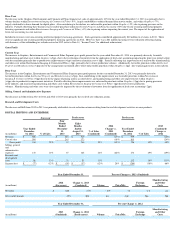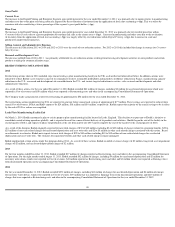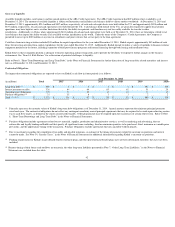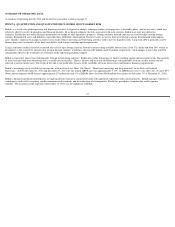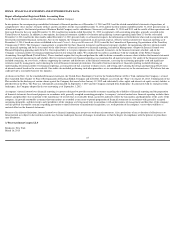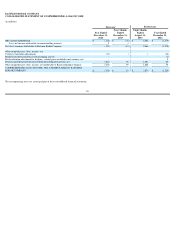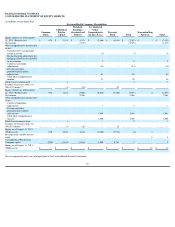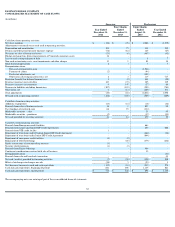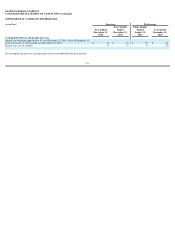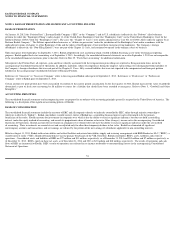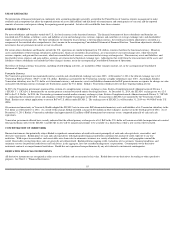Kodak 2014 Annual Report Download - page 48
Download and view the complete annual report
Please find page 48 of the 2014 Kodak annual report below. You can navigate through the pages in the report by either clicking on the pages listed below, or by using the keyword search tool below to find specific information within the annual report.
ITEM 8. FINANCIAL STATEMENTS AND SUPPLEMENTARY DATA
Report of Independent Registered Public Accounting Firm
To the Board of Directors and Shareholders of Eastman Kodak Company
In our opinion, the accompanying consolidated statement of financial position as of December 31, 2014 and 2013 and the related consolidated statements of operations, of
comprehensive (loss) income, of equity (deficit) and of cash flows for the year ended December 31, 2014 and for the four months ended December 31, 2013 present fairly, in
all material respects, the financial position of Eastman Kodak Company and its subsidiaries (Successor) at December 31, 2014 and 2013 and the results of their operations and
their cash flows for the year ended December 31, 2014 and the four months ended December 31, 2013 in conformity with accounting principles generally accepted in the
United States of America. In addition, in our opinion, the financial statement schedule of valuation and qualifying accounts appearing under Item 15 for the year ended
December 31, 2014 and for the four months ended December 31, 2013 presents fairly, in all material respects, the information set forth therein when read in conjunction with
the related consolidated financial statements. Also in our opinion, the Company maintained, in all material respects, effective internal control over financial reporting as of
December 31, 2014, based on criteria established in Internal Control—Integrated Framework (2013) issued by the Committee of Sponsoring Organizations of the Treadway
Commission (COSO). The Company’s management is responsible for these financial statements and financial statement schedule, for maintaining effective internal control
over financial reporting and for its assessment of the effectiveness of internal control over financial reporting, included in Management’s Report on Internal Control over
Financial Reporting appearing under Item 9A. Our responsibility is to express opinions on these financial statements, on the financial statement schedule, and on the
Company’s internal control over financial reporting based on our integrated audits. We conducted our audits in accordance with the standards of the Public Company
Accounting Oversight Board (United States). Those standards require that we plan and perform the audit to obtain reasonable assurance about whether the financial statements
are free of material misstatement and whether effective internal control over financial reporting was maintained in all material respects. Our audits of the financial statements
included examining, on a test basis, evidence supporting the amounts and disclosures in the financial statements, assessing the accounting principles used and significant
estimates made by management, and evaluating the overall financial statement presentation. Our audit of internal control over financial reporting included obtaining an
understanding of internal control over financial reporting, assessing the risk that a material weakness exists, and testing and evaluating the design and operating effectiveness
of internal control based on the assessed risk. Our audits also included performing such other procedures as we considered necessary in the circumstances. We believe that our
audits provide a reasonable basis for our opinions.
As discussed in Note 1 to the consolidated financial statements, the United States Bankruptcy Court for the Southern District of New York confirmed the Company’s revised
First Amended Joint Chapter 11 Plan of Reorganization of Eastman Kodak Company and its Debtor Affiliates (as revised, the “Plan”)
on August 23, 2013. Confirmation of the
Plan resulted in the discharge of certain claims against the Company that arose before January 19, 2012 and substantially alters rights and interests of equity security holders as
provided for in the Plan. The Plan was substantially consummated on September 3, 2013 and the Company emerged from bankruptcy. In connection with its emergence from
bankruptcy, the Company adopted fresh start accounting as of September 1, 2013.
A company’s internal control over financial reporting is a process designed to provide reasonable assurance regarding the reliability of financial reporting and the preparation
of financial statements for external purposes in accordance with generally accepted accounting principles. A company’s internal control over financial reporting includes those
policies and procedures that (i) pertain to the maintenance of records that, in reasonable detail, accurately and fairly reflect the transactions and dispositions of the assets of the
company; (ii) provide reasonable assurance that transactions are recorded as necessary to permit preparation of financial statements in accordance with generally accepted
accounting principles, and that receipts and expenditures of the company are being made only in accordance with authorizations of management and directors of the company;
and (iii) provide reasonable assurance regarding prevention or timely detection of unauthorized acquisition, use, or disposition of the company’s assets that could have a
material effect on the financial statements.
Because of its inherent limitations, internal control over financial reporting may not prevent or detect misstatements. Also, projections of any evaluation of effectiveness to
future periods are subject to the risk that controls may become inadequate because of changes in conditions, or that the degree of compliance with the policies or procedures
may deteriorate.
/s/ PricewaterhouseCoopers LLP
Rochester, New York
March 16, 2015
45




